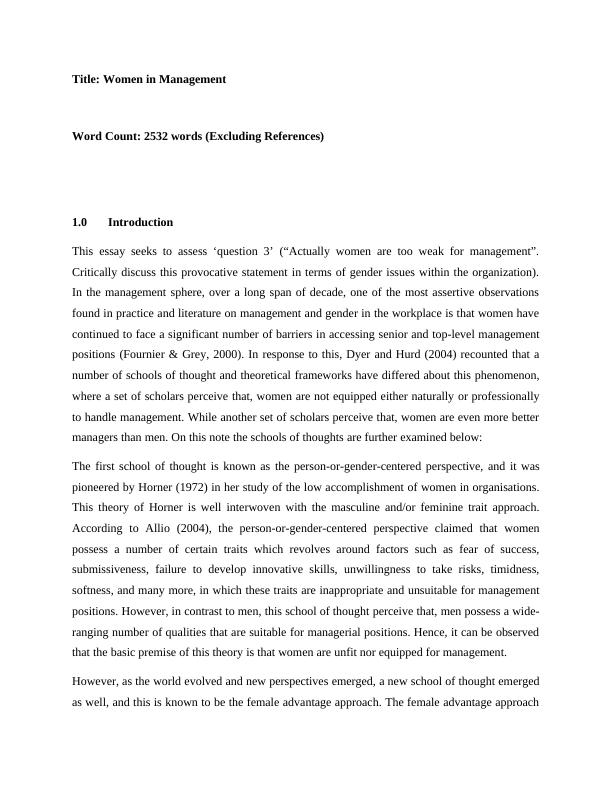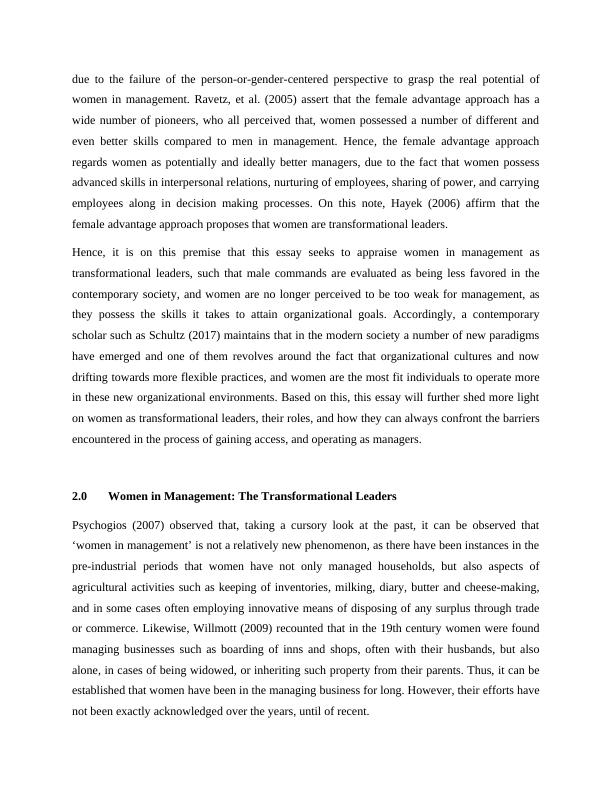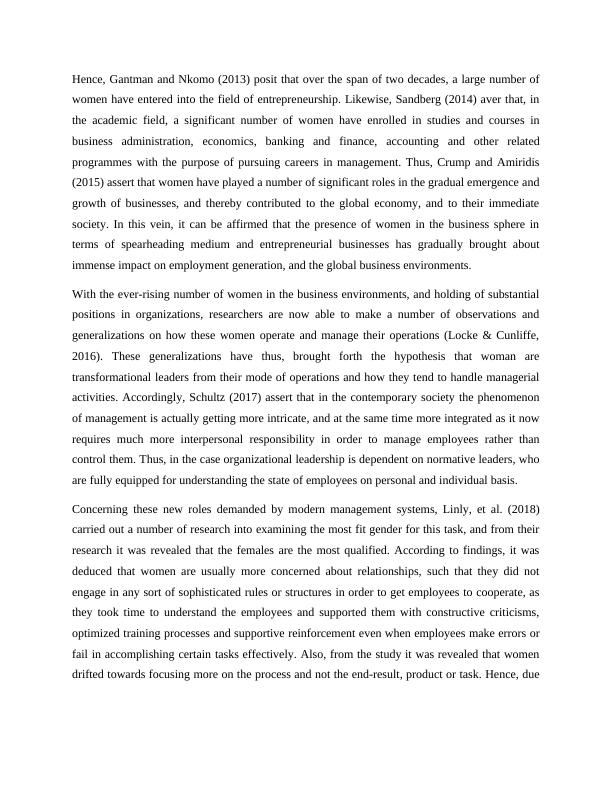Ask a question from expert
Women in Management PDF
10 Pages3763 Words41 Views
Added on 2021-10-13
Women in Management PDF
Added on 2021-10-13
BookmarkShareRelated Documents
Title: Women in Management
Word Count: 2532 words (Excluding References)
1.0 Introduction
This essay seeks to assess ‘question 3’ (“Actually women are too weak for management”.
Critically discuss this provocative statement in terms of gender issues within the organization).
In the management sphere, over a long span of decade, one of the most assertive observations
found in practice and literature on management and gender in the workplace is that women have
continued to face a significant number of barriers in accessing senior and top-level management
positions (Fournier & Grey, 2000). In response to this, Dyer and Hurd (2004) recounted that a
number of schools of thought and theoretical frameworks have differed about this phenomenon,
where a set of scholars perceive that, women are not equipped either naturally or professionally
to handle management. While another set of scholars perceive that, women are even more better
managers than men. On this note the schools of thoughts are further examined below:
The first school of thought is known as the person-or-gender-centered perspective, and it was
pioneered by Horner (1972) in her study of the low accomplishment of women in organisations.
This theory of Horner is well interwoven with the masculine and/or feminine trait approach.
According to Allio (2004), the person-or-gender-centered perspective claimed that women
possess a number of certain traits which revolves around factors such as fear of success,
submissiveness, failure to develop innovative skills, unwillingness to take risks, timidness,
softness, and many more, in which these traits are inappropriate and unsuitable for management
positions. However, in contrast to men, this school of thought perceive that, men possess a wide-
ranging number of qualities that are suitable for managerial positions. Hence, it can be observed
that the basic premise of this theory is that women are unfit nor equipped for management.
However, as the world evolved and new perspectives emerged, a new school of thought emerged
as well, and this is known to be the female advantage approach. The female advantage approach
Word Count: 2532 words (Excluding References)
1.0 Introduction
This essay seeks to assess ‘question 3’ (“Actually women are too weak for management”.
Critically discuss this provocative statement in terms of gender issues within the organization).
In the management sphere, over a long span of decade, one of the most assertive observations
found in practice and literature on management and gender in the workplace is that women have
continued to face a significant number of barriers in accessing senior and top-level management
positions (Fournier & Grey, 2000). In response to this, Dyer and Hurd (2004) recounted that a
number of schools of thought and theoretical frameworks have differed about this phenomenon,
where a set of scholars perceive that, women are not equipped either naturally or professionally
to handle management. While another set of scholars perceive that, women are even more better
managers than men. On this note the schools of thoughts are further examined below:
The first school of thought is known as the person-or-gender-centered perspective, and it was
pioneered by Horner (1972) in her study of the low accomplishment of women in organisations.
This theory of Horner is well interwoven with the masculine and/or feminine trait approach.
According to Allio (2004), the person-or-gender-centered perspective claimed that women
possess a number of certain traits which revolves around factors such as fear of success,
submissiveness, failure to develop innovative skills, unwillingness to take risks, timidness,
softness, and many more, in which these traits are inappropriate and unsuitable for management
positions. However, in contrast to men, this school of thought perceive that, men possess a wide-
ranging number of qualities that are suitable for managerial positions. Hence, it can be observed
that the basic premise of this theory is that women are unfit nor equipped for management.
However, as the world evolved and new perspectives emerged, a new school of thought emerged
as well, and this is known to be the female advantage approach. The female advantage approach

due to the failure of the person-or-gender-centered perspective to grasp the real potential of
women in management. Ravetz, et al. (2005) assert that the female advantage approach has a
wide number of pioneers, who all perceived that, women possessed a number of different and
even better skills compared to men in management. Hence, the female advantage approach
regards women as potentially and ideally better managers, due to the fact that women possess
advanced skills in interpersonal relations, nurturing of employees, sharing of power, and carrying
employees along in decision making processes. On this note, Hayek (2006) affirm that the
female advantage approach proposes that women are transformational leaders.
Hence, it is on this premise that this essay seeks to appraise women in management as
transformational leaders, such that male commands are evaluated as being less favored in the
contemporary society, and women are no longer perceived to be too weak for management, as
they possess the skills it takes to attain organizational goals. Accordingly, a contemporary
scholar such as Schultz (2017) maintains that in the modern society a number of new paradigms
have emerged and one of them revolves around the fact that organizational cultures and now
drifting towards more flexible practices, and women are the most fit individuals to operate more
in these new organizational environments. Based on this, this essay will further shed more light
on women as transformational leaders, their roles, and how they can always confront the barriers
encountered in the process of gaining access, and operating as managers.
2.0 Women in Management: The Transformational Leaders
Psychogios (2007) observed that, taking a cursory look at the past, it can be observed that
‘women in management’ is not a relatively new phenomenon, as there have been instances in the
pre-industrial periods that women have not only managed households, but also aspects of
agricultural activities such as keeping of inventories, milking, diary, butter and cheese-making,
and in some cases often employing innovative means of disposing of any surplus through trade
or commerce. Likewise, Willmott (2009) recounted that in the 19th century women were found
managing businesses such as boarding of inns and shops, often with their husbands, but also
alone, in cases of being widowed, or inheriting such property from their parents. Thus, it can be
established that women have been in the managing business for long. However, their efforts have
not been exactly acknowledged over the years, until of recent.
women in management. Ravetz, et al. (2005) assert that the female advantage approach has a
wide number of pioneers, who all perceived that, women possessed a number of different and
even better skills compared to men in management. Hence, the female advantage approach
regards women as potentially and ideally better managers, due to the fact that women possess
advanced skills in interpersonal relations, nurturing of employees, sharing of power, and carrying
employees along in decision making processes. On this note, Hayek (2006) affirm that the
female advantage approach proposes that women are transformational leaders.
Hence, it is on this premise that this essay seeks to appraise women in management as
transformational leaders, such that male commands are evaluated as being less favored in the
contemporary society, and women are no longer perceived to be too weak for management, as
they possess the skills it takes to attain organizational goals. Accordingly, a contemporary
scholar such as Schultz (2017) maintains that in the modern society a number of new paradigms
have emerged and one of them revolves around the fact that organizational cultures and now
drifting towards more flexible practices, and women are the most fit individuals to operate more
in these new organizational environments. Based on this, this essay will further shed more light
on women as transformational leaders, their roles, and how they can always confront the barriers
encountered in the process of gaining access, and operating as managers.
2.0 Women in Management: The Transformational Leaders
Psychogios (2007) observed that, taking a cursory look at the past, it can be observed that
‘women in management’ is not a relatively new phenomenon, as there have been instances in the
pre-industrial periods that women have not only managed households, but also aspects of
agricultural activities such as keeping of inventories, milking, diary, butter and cheese-making,
and in some cases often employing innovative means of disposing of any surplus through trade
or commerce. Likewise, Willmott (2009) recounted that in the 19th century women were found
managing businesses such as boarding of inns and shops, often with their husbands, but also
alone, in cases of being widowed, or inheriting such property from their parents. Thus, it can be
established that women have been in the managing business for long. However, their efforts have
not been exactly acknowledged over the years, until of recent.

Hence, Gantman and Nkomo (2013) posit that over the span of two decades, a large number of
women have entered into the field of entrepreneurship. Likewise, Sandberg (2014) aver that, in
the academic field, a significant number of women have enrolled in studies and courses in
business administration, economics, banking and finance, accounting and other related
programmes with the purpose of pursuing careers in management. Thus, Crump and Amiridis
(2015) assert that women have played a number of significant roles in the gradual emergence and
growth of businesses, and thereby contributed to the global economy, and to their immediate
society. In this vein, it can be affirmed that the presence of women in the business sphere in
terms of spearheading medium and entrepreneurial businesses has gradually brought about
immense impact on employment generation, and the global business environments.
With the ever-rising number of women in the business environments, and holding of substantial
positions in organizations, researchers are now able to make a number of observations and
generalizations on how these women operate and manage their operations (Locke & Cunliffe,
2016). These generalizations have thus, brought forth the hypothesis that woman are
transformational leaders from their mode of operations and how they tend to handle managerial
activities. Accordingly, Schultz (2017) assert that in the contemporary society the phenomenon
of management is actually getting more intricate, and at the same time more integrated as it now
requires much more interpersonal responsibility in order to manage employees rather than
control them. Thus, in the case organizational leadership is dependent on normative leaders, who
are fully equipped for understanding the state of employees on personal and individual basis.
Concerning these new roles demanded by modern management systems, Linly, et al. (2018)
carried out a number of research into examining the most fit gender for this task, and from their
research it was revealed that the females are the most qualified. According to findings, it was
deduced that women are usually more concerned about relationships, such that they did not
engage in any sort of sophisticated rules or structures in order to get employees to cooperate, as
they took time to understand the employees and supported them with constructive criticisms,
optimized training processes and supportive reinforcement even when employees make errors or
fail in accomplishing certain tasks effectively. Also, from the study it was revealed that women
drifted towards focusing more on the process and not the end-result, product or task. Hence, due
women have entered into the field of entrepreneurship. Likewise, Sandberg (2014) aver that, in
the academic field, a significant number of women have enrolled in studies and courses in
business administration, economics, banking and finance, accounting and other related
programmes with the purpose of pursuing careers in management. Thus, Crump and Amiridis
(2015) assert that women have played a number of significant roles in the gradual emergence and
growth of businesses, and thereby contributed to the global economy, and to their immediate
society. In this vein, it can be affirmed that the presence of women in the business sphere in
terms of spearheading medium and entrepreneurial businesses has gradually brought about
immense impact on employment generation, and the global business environments.
With the ever-rising number of women in the business environments, and holding of substantial
positions in organizations, researchers are now able to make a number of observations and
generalizations on how these women operate and manage their operations (Locke & Cunliffe,
2016). These generalizations have thus, brought forth the hypothesis that woman are
transformational leaders from their mode of operations and how they tend to handle managerial
activities. Accordingly, Schultz (2017) assert that in the contemporary society the phenomenon
of management is actually getting more intricate, and at the same time more integrated as it now
requires much more interpersonal responsibility in order to manage employees rather than
control them. Thus, in the case organizational leadership is dependent on normative leaders, who
are fully equipped for understanding the state of employees on personal and individual basis.
Concerning these new roles demanded by modern management systems, Linly, et al. (2018)
carried out a number of research into examining the most fit gender for this task, and from their
research it was revealed that the females are the most qualified. According to findings, it was
deduced that women are usually more concerned about relationships, such that they did not
engage in any sort of sophisticated rules or structures in order to get employees to cooperate, as
they took time to understand the employees and supported them with constructive criticisms,
optimized training processes and supportive reinforcement even when employees make errors or
fail in accomplishing certain tasks effectively. Also, from the study it was revealed that women
drifted towards focusing more on the process and not the end-result, product or task. Hence, due

End of preview
Want to access all the pages? Upload your documents or become a member.